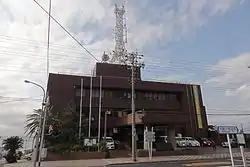Ōshima, Tokyo
Ōshima (大島町, Ōshima-machi) is a town located in Ōshima Subprefecture, Tokyo Metropolis, Japan. As of 1 February 2016, the town had an estimated population of 7,762, and a population density of 85.5 persons per km². Its total area is 90.76 square kilometres (35.04 sq mi).
Ōshima
大島町 | |
|---|---|
Town | |
 Ōshima Town Hall | |
 Flag  Seal | |
 Location of Ōshima in Tokyo Metropolis | |
 Ōshima | |
| Coordinates: 34°45′0.5″N 139°21′19.8″E | |
| Country | Japan |
| Region | Kantō |
| Prefecture | Tokyo Metropolis |
| First official recorded | 620 AD |
| Town settled | April 1, 1955 |
| Government | |
| • Mayor | Toshihiro Mitsuji (from April 2015) |
| Area | |
| • Total | 90.76 km2 (35.04 sq mi) |
| Population (June 1, 2016) | |
| • Total | 7,762 |
| • Density | 85.5/km2 (221/sq mi) |
| Time zone | UTC+9 (Japan Standard Time) |
| - Tree | Camellia japonica |
| - Flower | Camellia japonica |
| Phone number | 04992-2-1443 |
| Address | 1-1-14 Motomachi, Ōshima-machi, Tokyo 100-0101 |
| Website | www |
Geography
Ōshima Town covers the island of Izu Ōshima, in the Izu archipelago in the Philippine Sea, 120 kilometres (75 mi) south of central Tokyo.
Climate
| Climate data for Oshima, Tokyo | |||||||||||||
|---|---|---|---|---|---|---|---|---|---|---|---|---|---|
| Month | Jan | Feb | Mar | Apr | May | Jun | Jul | Aug | Sep | Oct | Nov | Dec | Year |
| Average high °C (°F) | 10.7 (51.3) |
11.2 (52.2) |
13.5 (56.3) |
18.0 (64.4) |
21.5 (70.7) |
24.0 (75.2) |
27.1 (80.8) |
29.2 (84.6) |
26.2 (79.2) |
21.5 (70.7) |
17.4 (63.3) |
13.3 (55.9) |
19.5 (67.1) |
| Daily mean °C (°F) | 7.3 (45.1) |
7.4 (45.3) |
9.9 (49.8) |
14.2 (57.6) |
17.9 (64.2) |
20.8 (69.4) |
24.1 (75.4) |
25.7 (78.3) |
23.0 (73.4) |
18.5 (65.3) |
14.2 (57.6) |
9.9 (49.8) |
16.1 (61.0) |
| Average low °C (°F) | 3.7 (38.7) |
3.4 (38.1) |
6.2 (43.2) |
10.3 (50.5) |
14.5 (58.1) |
18.1 (64.6) |
21.8 (71.2) |
23.1 (73.6) |
20.5 (68.9) |
15.7 (60.3) |
11.0 (51.8) |
6.2 (43.2) |
12.9 (55.2) |
| Average rainfall mm (inches) | 130.5 (5.14) |
146.9 (5.78) |
258.2 (10.17) |
238.7 (9.40) |
259.8 (10.23) |
337.8 (13.30) |
246.5 (9.70) |
231.0 (9.09) |
353.1 (13.90) |
329.0 (12.95) |
194.9 (7.67) |
100.8 (3.97) |
2,827.1 (111.30) |
| Average rainy days | 17.4 | 16.3 | 21.1 | 18.3 | 18.3 | 20.8 | 20.7 | 17.3 | 20.7 | 19.7 | 15.9 | 14.6 | 221.1 |
| Average relative humidity (%) | 64 | 65 | 69 | 75 | 79 | 84 | 87 | 86 | 83 | 77 | 73 | 67 | 76 |
| Mean monthly sunshine hours | 151.7 | 142.8 | 148.6 | 168.5 | 171.6 | 127.3 | 142.6 | 190.6 | 135.9 | 137.2 | 138.7 | 149.3 | 1,804.9 |
| Source: [1] | |||||||||||||
History

It is uncertain when human settlement first began on Ōshima, but archaeological finds from the Jōmon period have been discovered, and the island is mention from early Nara period documents. It is mentioned in historical records for its many volcanic eruptions. After the start of the Meiji period, in 1878, the island came under the control of Tokyo-fu and was organized into six villages (Okada, Motomura, Senzu, Nomashi, Sashikiji and Habuminato) under Oshima subprefecture on April 1, 1908. The six villages were merged to form Ōshima Town on April 1,1955.
In the mid-1930s, Izu Ōshima became a popular suicide destination after three schoolgirls jumped into the active volcano in the center of the island. In 1935 alone, more than 800 suicides were recorded.[2]
The central volcano on the island, Mount Mihara erupted in 1965 and again in 1986, forcing the temporary evacuation of the inhabitants.
On 16 October 2013, Typhoon Wipha passed over the island, dropping 80 cm (31 in) of rain in 24 hours and causing a landslide that killed 35 people.[3]
Economy
Fishing and seasonal tourism are the mainstays of the economy of Ōshima.
Education
Ōshima town operates three public elementary schools and three public middle schools. The Tokyo Metropolitan Board of Education operated two high schools. Ōshima High School is an agriculture school known for producing baseball players, and Ōshima International Maritime Academy is a marine biology school. Ōshima High School is attended primarily by children native to the island. Ōshima International Maritime Academy draws students from mainland Tokyo and neighboring Izu in order to participate in its marine biology program.
Sister city relations
![]() - Hilo, Hawaii, United States
- Hilo, Hawaii, United States
Local attractions
The island is known for its Camellia Festival, Hanabi Festival, five black sand beaches, and several onsen.
References
- 過去の気象データ検索: 平年値(年・月ごとの値) ("Historical Climate data for Oshima"). Japan Meteorological Agency.
- "Japan's Fiery Pit of Death". Chicago Tribune. May 10, 1936. Retrieved June 5, 2016.
- Kyodo, Jiji. "Izu-Oshima Island holds memorial for mudslide victims of Typhoon Wipha". The Japan Times. Retrieved 8 December 2013.
External links
| Wikimedia Commons has media related to Oshima, Tokyo. |
- Ōshima Town Official Website (in Japanese)
